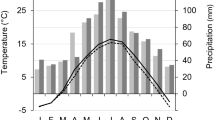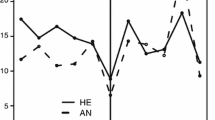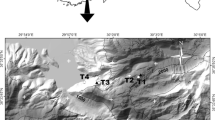Abstract
This paper illustrates the effects of abrupt stem burial (burial depth ~0.5 m) on tree growth in mature (46 ± 8 years) European larch (Larix decidua Mill.) trees. In contrast to the previous research, which was mostly carried out with saplings and on experimental sites where regular aggradation occurred through the transport of sand, this work focuses on the impact of natural, abrupt burial of mature trees with rocks contained in a sandy-silty matrix typical for debris flows in mountainous headwater catchments. The effect of burial is assessed radially and axially within the stem and over almost three decades after burial. The analysis of growth disturbances and their intensity was based on the 143 cross sections (572 growth series) taken at 10-cm intervals from 6 Larix decidua Mill. The results show quite clearly that abrupt burial causes massive suppression of radial growth as compared to pre-event conditions (mean 77 %, min 38 %, max 92 %, SD 7.2 %). The trees sampled were unable to resume pre-burial growth rates even after 25 years, but recovered to reference growth conditions (as measured in undisturbed, local reference trees) after 15 years (min 3 years, max 25 years, SD 9 years). The results differ only insignificantly between different heights along the tree axis and suppression is equally well expressed at different radial positions within the stem.




Similar content being viewed by others
References
Alestalo J (1971) Dendrochronological interpretation of geomorphic processes. Fennia 105:1–139
Bearth P (1973) Geologischer Atlas der Schweiz, Erläuterungen, 1:25’000, Blatt Simplon, Atlasblatt 61. Schweiz Geol Kommission
Bégin C, Michaud Y, Filion L (1995) Dynamics of a Holocene cliff-top dune along Mountain River, Northwest Territories, Canada. Quat Res 44:392–404
Bollschweiler M, Stoffel M, Schneuwly DM, Bourqui K (2008) Traumatic resin ducts in Larix decidua stems impacted by debris flows. Tree Physiol 28:255–263
Cournoyer L, Filion L (1994) Variation in wood anatomy of white spruce in response to dune activity. Arct Antarct Alp Res 26:412–417
Day SD, Seiler JR, Kreh R, Smith DW (2001) Overlaying compacted or uncompacted construction fill has no negative impact on white oak and sweetgum growth and physiology. Can J For Res 31:100–109
Dech JP (2004) The ecological significance of sand burial to woody plants on coastal sand dunes. Dissertation, University of Western Ontario
Dech JP, Maun MA (2006) Adventitious root production and plastic resource allocation to biomass determine burial tolerance in woody plants from central Canadian coastal dunes. Ann Bot 98:1095–1105
Den Ouden J, Sass-Klaassen UGW, Copini P (2007) Dendrogeomorphology—a new tool to study drift-sand dynamics. Neth J Geosci 86:355–363
Eldred RA, Maun MA (1982) A multivariate approach to the problem of decline in vigour of Ammophila. Can J Bot 60:1371–1380
Filion L, Marin P (1988) Modifications morphologiques de l’épinette blanche sourmise à la sedimentation éolienne en milieu dunaire, Québec subarctique. Can J Bot 66:1862–1869
Friedman J, Vincent KR, Shafroth PB (2005) Dating floodplain sediments using tree-ring response to burial. Earth Surf Process Landf 30:1077–1091
Heikkinen O, Tikkanen M (1987) Thekalajoki dune field on the west coast of Finland. Fennia 165:241–267
Hupp CR (1988) Plant ecological aspect of flood geomorphology and paleoflood history. In: Baker VR, Kochel RC, Patton PC (eds) Flood geomorphology. Wiley, New York, pp 335–356
Jury WA, Horton R (2004) Soil physics. Wiley, Oxford, p 384
Kent M, Owen NW, Dale P, Newham RM, Giles TM (2001) Studies of vegetation burial: a focus for biogeography and biogeomorphology? Prog Phys Geog 25:455–482
Kny L (1877) Das Dickenwachstum des Holzkörpers an beblätterten Sprossen und Wurzeln und seine Abhängigkeit von äußeren Einflüssen, insbesondere von Schwerkraft und Druck. Bot Z 35:415–466
Kroprowski M, Winchester V, Zielski A (2010) Tree reactions and dune movemtns: Slowinski National Parks, Poland. Catena 81:55–65
Little LR, Maun MA (1996) The ‘Ammophila’ problem revisited: arole for mycorrhizal fungi. J Ecol 53:447–463
Liu B, Fujita T, Yan ZH, Sakamoto S, Xu D, Abe J (2007) QTL mapping of domestication related traits in soybean (Glycine max). Ann Bot 100:1027–1038
Marin P, Filion L (1992) Recent dynamics of subarctic dunes ad determined by tree-ring analysis of white spruce, Hudson Bay, Quebec. Quat Res 38:316–330
Matisons R, Brümelis G (2008) Effects of burial by sand on Scots pine (Pinus sylvestrisL.) radial growth on seacoast wooded dunes at Cape Kolka, Latvia. Acta Univ Latv 745:131–144
Maun MA (1998) Adaptations of plants to burial in coastal sand dunes. Can J Bot 76:713–738
Maun MA (2004) Adaptiations of plants to burial in coastal sand dunes. Can J Bot 76:713–738
Mayer B, Stoffel M, Bollschweiler M, Hübl J, Rudolf-Miklau F (2010) Frequency and spread of debris floods on fans: a dendrogeomorphic case study from a dolomite catchment in the Austrian Alps. Geomorphology 118:199–206
MeteoSwiss (2008) Federal Office of Meteorology and Climatology, MeteoSwiss. http://www.meteo-schweiz.ch
Müller HN (1980) Angewandte Pflanzensoziologie; Jahrringwachstum und Klimafaktoren, Österreichischer Agrarverlag, Wien, Heft 25
Nanson GC, Beach HF (1977) Forest succession and sedimentation on a meandering-river floodplain, northeast British Columbia. Can J Biogeogr 4:229–251
Rinntech (2011) LINTAB—Präzision—Jahrring für Jahrring. http://www.rinntech.com/content/view/16/47/lang,german. Accessed 10 Oct 2011
Rubner K (1919) Das Hungern des Cambiums und das Aussetzen der Jahrringe. Naturwiss Z Fors-Landwirtsch 8:212–262
Rubtsov MV, Salmina IUN (1983) Use of buried Salix thickets for determination of the chronology of floodplain deposits. Lesovedenie 5:69–70
Shi L, Zhang ZF, Zhang CY, Zhang JZ (2004) Effects of sand burial on survival, growth, gas exchange and biomass allocation of Ulmus pumilla seedlings in the Hunshandak Sandland, China. Ann Bot 94:553–560
Shroder JF (1978) Dendrogeomorphological analysis of mass movement on Table Cliff Plateau, Utah. Quat Res 9:168–185
Singh G, Rathod TR (2002) Plant growth, biomass production and soil water dynamics in a shifting dune of Indian desert. For Ecol Manage 171:309–321
Stoffel M, Bollschweiler M (2008) Tree-ring analysis in natural hazards research—an overview. Nat Hazard Earth Sys Sci 8:187–202
Stoffel M, Bollschweiler M (2009) What tree rings can tell about earth-surface processes: teaching the principles of dendrogeomorphology. Geogr Compass 3:113–137
Stoffel M, Lièvre I, Conus D, Grichting MA, Raetzo H, Gärtner HW, Monbaron M (2005) 400 years of debris flow activity and triggering weather conditions: Ritigraben VS, Switzerland. Arctic Antarc Alp Res 37:387–395
Stoffel M, Conus D, Grichting MA, Lièvre I, Maître G (2008) Unraveling the patterns of late Holocene debris-flow activity on a cone in the central Swiss Alps: chronology, environment and implications for the future. Glob Planet Change 60:222–234
Stoffel M, Corona C, Ballesteros Canovas JA, Bodoque del Pozo JM (in press) Dating and quantification of erosion processes using exposed roots. Earth Sci Rev
Strunk H (1991) Frequency distribution of debris flows in the Alps since the “Little Ice Age”. Zeitschrift für Geomorphologie 83:71–81
Strunk H (1995) Dendrogeomorphologische Methoden zur Ermittlung der Murfrequenz und Beispiele ihrer Anwendung. Roderer Verlag, Regensburg
Strunk H (1997) Dating of geomophological processes using dendrogeomrphological methods. Catena 31:137–151
Yoshihika AM, Hukusima T (1997) The impact of extreme runoff events from the Sakasagawa river on the Senjogahra ecosystem, Nikko National Park V. The importance of adventitious root systems for the burial tolerance of different tree species. Ecol Res 12:39–46
Zhang J, Maun MA (1990) Effects of sand burial on seed germination, seedling emergence, survival, and growth of Agropyron psammophilum. Can J Bot 68:304–310
Zhao WZ, LI QY, Fang HY (2007) Effects of sand burial on seedling growth of Nitrariasphaerocarpa. Plant Soil 295:95–102
Author information
Authors and Affiliations
Corresponding author
Additional information
Communicated by L. Gratani.
Rights and permissions
About this article
Cite this article
Kogelnig-Mayer, B., Stoffel, M. & Schneuwly-Bollschweiler, M. Four-dimensional growth response of mature Larix decidua to stem burial under natural conditions. Trees 27, 1217–1223 (2013). https://doi.org/10.1007/s00468-013-0870-4
Received:
Accepted:
Published:
Issue Date:
DOI: https://doi.org/10.1007/s00468-013-0870-4




